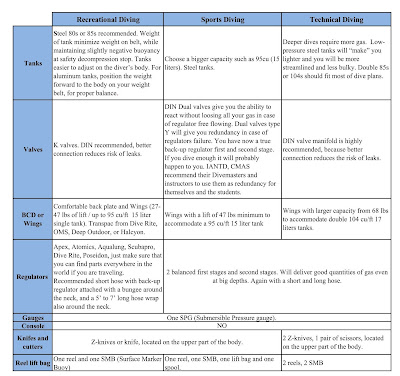Keeping an open mind about gear configuration Part 2
On our last blog we talked about Cavern and Intro-To-Cave diver's gear configuration. Today let's talk and review the cave diver configuration using double tanks.
The basics of the "Hogarth configuration"
William "Bill" Hogarth Main is a cave diving pioneer who is best known as a developer in the 1980s, and the namesake of, the "Hogarthian gear configuration" that is a component of the "Doing It Right" (DIR) holistic approach to scuba diving. According to Jarrod Jablonski, the Hogarthian style "has many minor variations, yet its focus asserts a policy of minimalism."[1] The configuration was refined in the 1990s, partially through the Woodville Karst Plain Project (WKPP),[2] established in 1985 and considered among the most aggressive cave diving initiatives in the world.
https://en.wikipedia.org/wiki/William_Hogarth_Main
It has been taught in the IANTD Essentials there is still some minor variations based on preferences, and personal safety. As the world is made of different colors, taste and thoughts, it is important to keep a "thinking cave diver" instead of a "following cave diver" who uses techniques not based on his personal experiences and way of thinking.
What works works:
Let's not reinvent the wheel but consoled it if needed.
 The Author personal configuration:
The Author personal configuration:
On our last blog we talked about Cavern and Intro-To-Cave diver's gear configuration. Today let's talk and review the cave diver configuration using double tanks.
The basics of the "Hogarth configuration"
William "Bill" Hogarth Main is a cave diving pioneer who is best known as a developer in the 1980s, and the namesake of, the "Hogarthian gear configuration" that is a component of the "Doing It Right" (DIR) holistic approach to scuba diving. According to Jarrod Jablonski, the Hogarthian style "has many minor variations, yet its focus asserts a policy of minimalism."[1] The configuration was refined in the 1990s, partially through the Woodville Karst Plain Project (WKPP),[2] established in 1985 and considered among the most aggressive cave diving initiatives in the world.
https://en.wikipedia.org/wiki/William_Hogarth_Main
It has been taught in the IANTD Essentials there is still some minor variations based on preferences, and personal safety. As the world is made of different colors, taste and thoughts, it is important to keep a "thinking cave diver" instead of a "following cave diver" who uses techniques not based on his personal experiences and way of thinking.
What works works:
Let's not reinvent the wheel but consoled it if needed.
The main recommendations to a good gear
configuration are:
- Redundancy
- Streamlining
- Accessibility
- Comfort
Let's see the differences between Recreational, Sport and cave diving (Technical diving configuration)
Let's see the differences between Recreational, Sport and cave diving (Technical diving configuration)
- Low Pressure Doubles 85's gives me plenty of gas for most of my diving, an Aluminum plate with a "purist" harness mounted on a Dive-Rite Classic wing.
- Regulators Mk 25 Scubapro with S-600 and G-250 second stages for the easy fixing on the spot works very well in warm to temperate water temperature since I do not dive cold water much.
- First regulator on the right post connected with a long hose and a MP hose for my dry suit connection. Most of people will have the MP dry suit inflation on the left post.
- Second regulator with shorter hose attached with a bungee around my neck, with a MP hose connected to my wing inflator.
Advantages for me of MP Dry suit hose on the right:
- If one of the first stage fails, that would probably be the one I use most, the one with the long hose. (happens to me twice in 20 years of teaching) in that case if i must isolate that regulator, I will not lose my BCD but only my Drysuit. I like to be able to keep my buoyancy without having to disconnect hoses.
-If I have a roll-off cave diving, and I have developed a bad habit of not checking my left post enough, I should be able to see it, because I'am using my power inflator more than my dry suit inflator at depth.
- I like to use both regulator during the dive, specially on deep dive where my primary regulator would work better if I do not ask him to much. Breathing and adding gas in the wings may sometime be too much, even if today's regulators are pretty efficient at depht I follow the "Eggs principles". Do not put them all in the same basket.
Once again there is different ways of configuring the Equipment, as we can see on the Essentials video. The main idea is to know why we use a system instead of of the other. This is one of the valuable way of thinking I have learned with my different cave mentors from the NACD, NSS/CDS and IANTD. what works for you may not work for me because humans are different in theirs habits and way of thinking.
Georges Gawinowski
WDT dive
WDT dive










